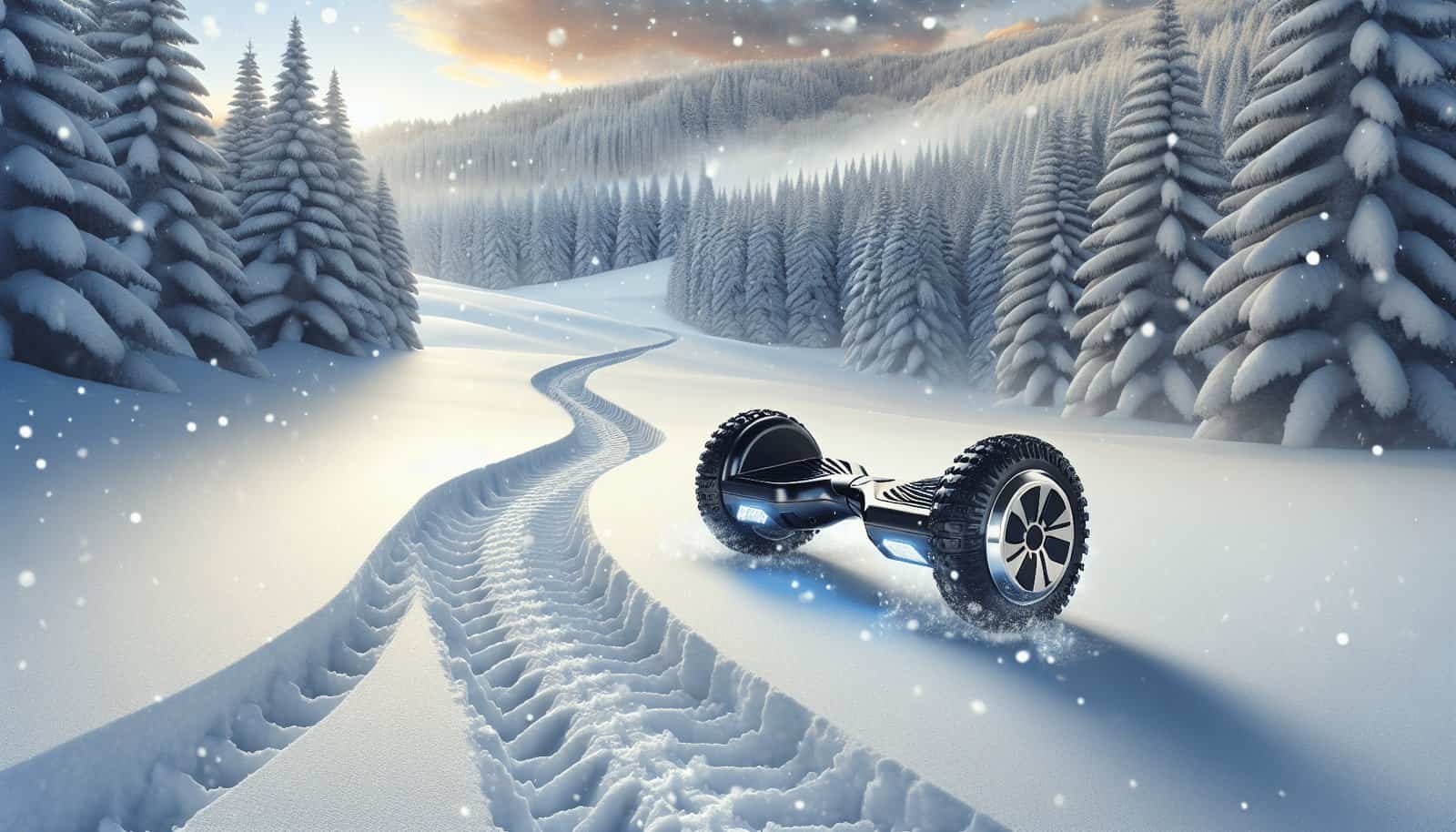Have you ever wondered if you can ride a hoverboard in snowy conditions and how well it handles winter weather? Winter brings a magical transformation of the landscape, blanketing everything in a layer of snow and creating a wonderland of adventure. However, it also ushers in concerns for those who love to ride their hoverboards. Safety, functionality, and the longevity of your hoverboard become key considerations when deciding whether you can navigate this winter wonderland. In this comprehensive guide, we’ll break down everything you need to know about riding a hoverboard in snowy and icy conditions.

Understanding Hoverboards
Before diving into how hoverboards perform in snowy conditions, it’s essential to grasp what a hoverboard is and its general functionalities.
What is a Hoverboard?
A hoverboard is a two-wheeled, self-balancing scooter that has taken the world by storm. It operates using gyroscopes and acceleration sensors, which detect the rider’s weight distribution and movement to provide balance and mobility. Most hoverboards are powered by lithium-ion batteries and can reach speeds between 6 to 12 mph.
Basic Components
Understanding the basic components of a hoverboard can give you a better grasp of its functionality and what might be affected by winter conditions.
| Component | Function |
|---|---|
| Wheels | Provide movement and support. |
| Gyroscope | Helps maintain balance by detecting shifts in the rider’s weight. |
| Battery | Supplies the power required to run the hoverboard. |
| Motor | Drives the wheels, enabling the hoverboard to move. |
| Sensors | Detect weight distribution and help in steering. |
| Tires | Offer traction and grip, which is crucial for riding on different surfaces. |
Riding in Snow: Is it Feasible?
Challenges of Snowy Conditions
Snowy conditions pose a range of challenges that can affect the performance and safety of riding a hoverboard. Here are some significant aspects to consider:
Traction: Snow can significantly reduce the traction of your hoverboard’s tires. Lower traction increases the risk of slipping and losing balance.
Battery Performance: Cold temperatures can impact the efficiency and lifespan of your hoverboard’s battery. Lithium-ion batteries are known to suffer in extreme cold, reducing their range and performance.
Water Resistance: Most hoverboards are not fully waterproof. Snow melts can seep into the internal components, causing electrical malfunctions.
Visibility and Terrain: Snow and ice can hide obstacles and uneven terrain, increasing the risk of falls and injuries.
Design Limitations
Hoverboards are primarily designed for smooth surfaces, like sidewalks and indoor spaces. They generally have smaller wheels, making it difficult to navigate uneven or slippery surfaces like snow and ice. The design limitations can substantially reduce the usability and safety of your hoverboard in winter weather.
Improving Traction: Tires and Treads
Types of Tires
Hoverboards typically come with two types of tires:
Solid Rubber Tires: These are common in many hoverboards. They offer durability but can lack the flexibility to provide sufficient grip in snowy conditions.
Inflatable Tires: These are larger and provide better shock absorption and grip. They are more suited for rougher terrains but still have limitations in snow.
Choosing the Right Tread
Tire tread is crucial for maintaining traction in snowy or icy conditions.
| Tread Type | Terrain Best Suited For | Snow Capability |
|---|---|---|
| Smooth Tread | Indoor and smooth surfaces | Low traction in snow |
| Grooved Tread | Basic outdoor surfaces | Moderate traction in snow |
| Deep Tread | Rough and varied terrains | Higher traction in snow |
| Studded Tires | Icy and snowy conditions | Best traction in snow |
Deep treads or studded tires can offer better grip, but they are not commonly available on standard hoverboards. Modifying your hoverboard with traction aids can also be considered, though it might void your warranty.
Battery Performance in Cold Weather
Cold Temperature Effects
Cold temperatures are notorious for affecting battery performance. Lithium-ion batteries, common in hoverboards, can lose their efficiency. Here are some key points:
- Reduced Range: Cold weather can reduce the battery’s range by up to 50%.
- Slower Charging: Batteries charge more slowly in low temperatures.
- Decreased Lifespan: Repeated exposure to cold can shorten the overall lifespan of the battery.
Tips to Improve Battery Life in Winter
You can take measures to extend your battery’s performance even in colder weather:
- Keep Your Battery Warm: Store your hoverboard indoors when not in use.
- Pre-warm Before Use: Let the battery warm up naturally indoors before heading out.
- Shorter Rides: Plan shorter rides to avoid battery draining quickly.

Snowproofing Your Hoverboard
Water Resistance Level
Most hoverboards are not fully waterproof but come with varying degrees of water resistance:
| Water Resistance Level | Description |
|---|---|
| IP54 | Resistant to splashes of water |
| IP65 | Resistant to low-pressure water jets |
| IPX7 | Can be submerged in water temporarily |
Hoverboards with higher water resistance ratings offer better protection against snow and moisture but are generally more expensive.
Protective Gear and Mods
To better equip your hoverboard for the snow, consider investing in some protective gear:
- Protective Covers: These can shield the electrical components from snow and moisture.
- Weatherproof Coating: Spray-on coatings can provide an extra layer of protection.
- Sealant: Apply sealant to gaps and seams to prevent water ingress.
Safety Tips for Riding in Snow
Clothing and Gear
Wearing the right gear can make a huge difference in your safety and comfort:
- Helmet: Always wear a helmet to protect against falls.
- Gloves: Insulated gloves keep your hands warm and improve grip.
- Snow Boots: Offer better traction and keep your feet dry.
- Reflective Clothing: Increases visibility in low-light conditions.
Riding Techniques
Adapting your riding style can also enhance safety:
- Go Slow: Ride at a slower speed to maintain better control.
- Short Rides: Avoid long rides to minimize exposure to the cold.
- Avoid Icy Patches: Steer clear of ice to prevent slipping.
- Balanced Stance: Keep a balanced stance to react quickly to slips or uneven terrain.
Emergency Precautions
Be prepared for emergencies by taking these steps:
- Carrying a Phone: Always have a means to call for help if needed.
- Knowing Your Route: Familiarize yourself with your route to avoid unexpected obstacles.
- Buddy System: Riding with a friend can add an extra layer of safety.

Alternative Solutions
All-Terrain Hoverboards
Investing in an all-terrain hoverboard can solve many issues related to riding in snowy conditions. These hoverboards come with:
- Larger Tires: Provides better traction and stability.
- Enhanced Water Resistance: Protects better against moisture.
- Stronger Battery: Performs better in colder temperatures.
Snow-Specific Mobility Devices
If you find that riding a hoverboard in the snow is too risky, consider alternative winter mobility options:
- Electric Snowboards: Specifically designed for snow conditions.
- Fat Tires Bikes: Made to handle various winter terrains.
Conclusion
Can you ride a hoverboard in snowy conditions, and how well does it handle winter weather? While it is technically possible to ride a hoverboard in snow, it comes with considerable challenges and risks. Factors such as reduced traction, battery performance, and water resistance significantly impact its feasibility. By understanding these limitations, and employing the safety tips and modifications suggested, you can make more informed decisions.
Winter adventures on a hoverboard might be tempting, but ensuring your safety and the longevity of your device should always come first. Happy and safe riding!


